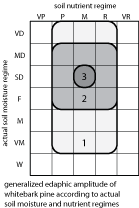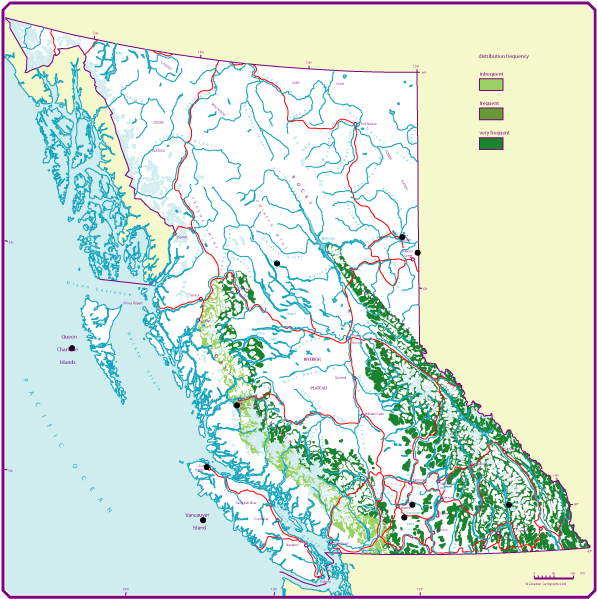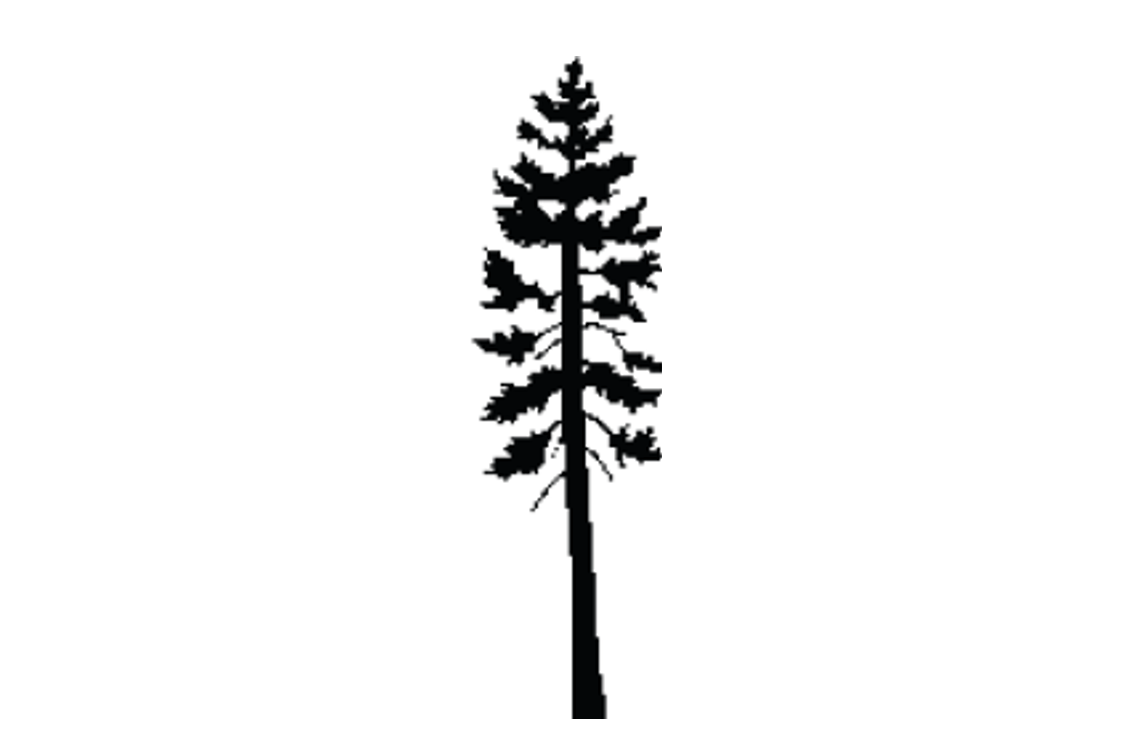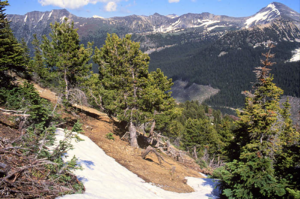Whitebark pine
Whitebark pine (Pa) - Pinus albicaulis
Whitebark pine is a small - to medium-sized (rarely >30m tall), slow-growing, long-lived tree of high mountains. When mature, it develops multi-stemmed growth form, with typically long branches and upswept branched crown, with brown, scaly bark.
Whitebark pine is not a timber crop species, but is valued for watershed protection and aesthetics. Its seeds are an important food for grizzly bears and other wildlife.
On this page
- Geographic range and ecological amplitudes
- Tolerances and Damaging Agents
- Silvical Characteristics
- Genetics and Notes
Geographic range and ecological amplitudes
Geographic range
Geographic element:
Western North American/mainly Cordilleran and less Pacific
Distribution in western North America:
(central) in the Pacific region; central and south in the Cordilleran region
Ecological amplitudes
Climatic amplitude:
(alpine tundra) - subalpine boreal - (cool temperate)
Orographic amplitude:
(montane) - subalpine
Occurrence in biogeoclimatic zones:
(lower, southern AT), upper submaritime MH, upper southern ESSF, (upper southern ICH)
Edaphic amplitude

Range of soil moisture regimes:
(very dry) - moderately dry - slightly dry - fresh - (moist) - (very moist)
Range of soil nutrient regimes:
poor - medium - rich
The most productive growth of whitebark pine occurs on rich sites (it is absent on very poor sites); therefore, it could be concluded from field observations carried out by Krajina (1969) that whitebark pine requires for productive growth higher amounts of calcium and magnesium than does lodgepole pine.
Tolerances and damaging agents
Root system characteristics
On most sites, whitebark pine develops a deep and spreading root system. It is well anchored, even on the rocky substrates and is seldom uprooted despite its large, exposed crown and the violent winds to which it is subjected. Roots of whitebark pine are associated with both ecto- and endo-mycorrhizae.
| Tolerance to | Tolerance class | Comments |
|---|---|---|
| low light | L | possibly moderately shade-tolerant on some sites |
| frost | H | |
| heat | M | summers are cool in subalpine boreal climates |
| water deficit | H | infrequent to frequent on water-deficient sites |
| water surplus | L | absent on waterlogged sites |
| nutrient (mainly N) deficiency | M | absent in very poor, acid soils |
| Damaging agent | Resistance class | Comments |
|---|---|---|
| snow | H | |
| wind | H |
| Risk class | ||
|---|---|---|
| fire | L | not a major concern in the upper subalpine forest |
| insect | H | a serious concern; mountain pine beetle, white pine weevil |
| fungi | M | white pine blister rust; root and butt rots not a serious concern (e.g., Red ring rot and annosus root and butt rot) |
| other agents | L | dwarf mistletoes (Arceuthobium spp.) |
Associated tree species and successional role
In British Columbia, whitebark pine grows in pure or mixed-species stands, mainly in broadly even-aged stands. With increasing elevation, the species grows in isolated clumps on exposed ridges and as krummholz. Whitebark pine is a pioneer (primary succession) and is present in early, mid-, and even late stages of secondary succession. During secondary succession, whitebark pine may be replaced by mountain hemlock (MH zone) or Engelmann spruce and subalpine fir (ESSF zone).
| Associated tree species |
Occurance class | Major area of occurance |
|---|---|---|
| limber pine | L | upper ESSF. |
| subalpine fir | L | upper ESSF. |
| engelmann spruce | L | upper ESSF. |
Genetics and notes
Genetics
Most of the wide phenotypic variation in growth form in whitebark pine is apparently the result of differences in site and climate.
Notes
Whitebark pines greatest values are for wildlife habitat, watershed protection, and aesthetics. More detailed silvics information is given by:
Arno, S.F. and R.J. Hoff. 1990. Pinus albicaulis. Pp. 268-279 in R.M. Burns and B.H. Honkala (technical coordinators) Silvics of North America, Vol 1. Agri. Handbook 654, USDA For. Serv., Washington, D.C.



